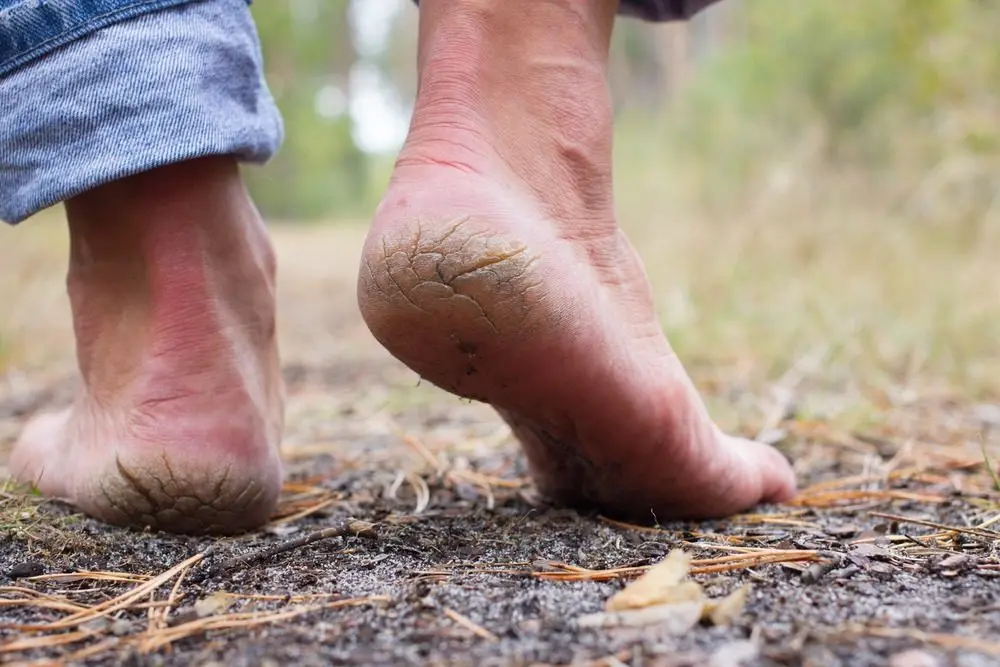
The heel is crucial for maintaining bodily equilibrium and it is exposed to extremely high pressure in order to complete this process.
The skin of the heel is normally not subjected to excessive pressure when the body is correctly balanced. However, in certain situations, the skin on this region of the foot isn’t properly stressed, or your skin is extremely sensitive to external factors.
This imbalance, when combined with friction and dryness of the heel, results in cracks.
The cracks, which are initially superficial, might later develop into very severe wounds and infection.
This skin condition can cause pain and discomfort, making walking difficult.
Heel cracks should be treated carefully, even if they are typically straightforward to cure.
Symptoms and warning signs
Cracked heels can go through several phases before they become a concern, even if they appear to be innocuous. Knowing how to detect the signs might help you intervene before it becomes an infection.
This pathology of the heel’s skin is clearly recognized. It exhibits the following characteristics prior to cracking:
- A tense skin when the heel is pressed
- A sensitive skin
- Considerable dryness
- Itching
- Brownish skin
If the skin of the heel isn’t properly cared for, it might deteriorate, resulting in painful fissures.
The symptoms then become:
- An extremely dry heel in its entirety
- A whitish, yellowish or reddish skin
- Peeling skin
- Bleeding in the heel
- Lesions that become infected
- Difficulty moving around
A wound that is not treated appropriately might develop to more dangerous infections in more advanced situations.
Athlete’s foot and bacterial infection are two diseases that can arise if the necessary circumstances occur.
Consult a podiatrist or a health care expert if you are concerned about specific symptoms or if the cracks are giving you discomfort.
He or she will be able to pinpoint the exact reasons for your disease and recommend the best course of treatment for you.
Causes and risk factors
Heel cracks can occur in response to a variety of factors.
Among others, we can mention situations such as
- A hot and dry climate
- Prolonged dehydration of untreated skin that prevents the regeneration of skin cells
- Untreated calluses that crack
- Regularly wearing open shoes
- Playing high-intensity sports such as running or tennis
- Choosing a shoe that does not fit properly or offers little support to the heel
- Walking barefoot
- Being overweight
- A diet low in vitamins and minerals
- Severe pronation of the feet
- Cavus feet
Cracked heels can also be caused by the following illnesses or conditions:
- Psoriasis: it dries out the skin and causes an inflammation that facilitates the appearance of heel cracks.
- Diabetes: the diabetic foot does not have the same natural hydration as the healthy foot, so it is more sensitive to calluses and cracks.
- Hypothyroidism: it dries and cools the skin, making it susceptible to cracking in various places.
Eczema: this skin condition causes patches and itching that allow cracks to develop.
Preventing heel cracks
Even though heel cracks seldom cause serious problems, it’s still vital to know how to avoid them.
To avoid them, simple yet efficient actions can be taken:
- Moisturize the heel and the soles of the feet on a daily basis
- Regularly remove accumulated horn with an exfoliating file
- Take foot baths to soften the skin and facilitate exfoliation
- Choose well-fitting shoes that adequately support the heels and forefoot
- Maintain a healthy weight
- Avoid sports that put excessive stress on the heel, such as running, without the proper footwear
- Avoid socks made of synthetic materials as much as possible
If none of these methods work, a visit to a podiatrist is recommended.
Treating heel cracks
The podiatrist is a specialist in all things related to the feet. Muscle discomfort, skeletal disorders, and foot dermatological issues can all be treated with this professional.
As a result, he or she can handle the diagnosis and treatment of heel cracks.
Following the podiatrist’s assessment of the foot, a variety of treatment options are offered. The podiatrist, on the other hand, will strive to choose the least intrusive treatments feasible.
These treatments might include the following:
- Foot care, with foot baths or emollient pre-treatment supervised by a medical team
- Custom-made foot orthotics to correct splaying and relieve cracked heels
- Removal of troublesome calluses that can cause injury
- Footwear adapted to the morphology of the foot, to give more support to the heel
- A specific bandage to protect the cracked heel during healing
- A prescription moisturizer
PiedReseau – Learn more
Would you like to learn more about foot dermatology? We offer a range of information on this topic on a regular basis!
Even while PiedRéseau is a valuable source of knowledge, nothing surpasses visiting a podiatrist in person.
Take care of your feet, they’re precious!